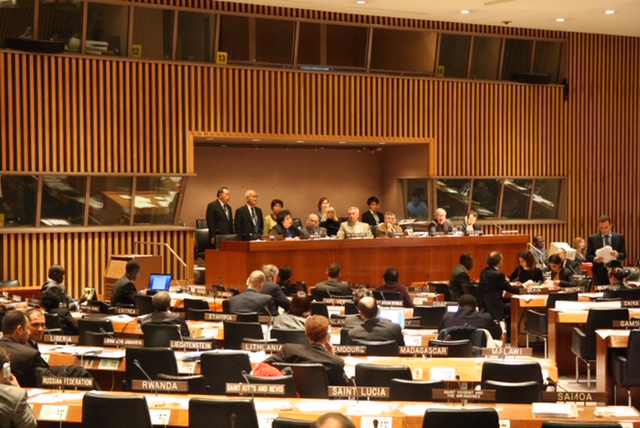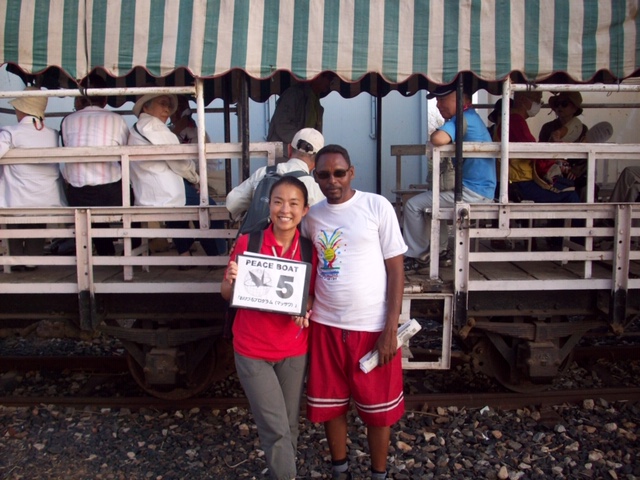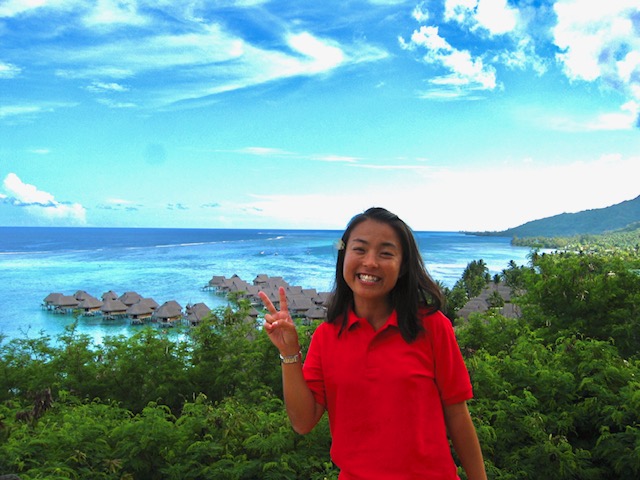USA Freelancing without a Parachute #2 – Around the world in 80+ Days
ON YOUR MARK
The branches whipped into the car furiously knocking my elderly friends off their seats. The brake’s harsh squeal was matched only by the piercing horn, alerting onlookers to step aside. The old steam engine roared down the curved, overgrown tracks at a ridiculous speed. I stood dumbfounded, unable to comprehend a single word the English speaking guide was saying. And believe it or not, I was loving every minute of it.
GET SET
Let me start at the beginning. There are two things I don’t handle very well. I don’t work very well when I’m hungry. And hot and humid weather is not a good combination for me either. When I arrived in Tokyo in early August, I was faced with the latter. I wasn’t hungry yet, but I was certainly very eager to get out to the field and start applying all the principles I had learned at the Middlebury Institute of International Studies at Monterey (MIIS). You see, I was there as a Communication Coordinator (CC). I was one of 14 chosen for the 63rd voyage of the NGO Peace Boat. Frankly, it was a terrible time to take the trip. The financial crisis of 2008 had just hit. And much fewer passengers had signed up as a result. However, this NGO knew how to make lemonade out of lemons. And it did something out of the norm which had a huge impact on the trajectory of my career – they invited 102 Hibakusha to travel around the world for free.
Growing up in Japan, I had heard Hibakusha testimonies and thought I knew the kind of stories they were going to be telling. So I felt confident about this aspect of the assignment – a little too confident, as it turned out. I had also just undergone some training for interpreting a Hibakusha while at MIIS. I wasn’t feeling very confident about all the other things I was going to do. You see, when you are on the boat, you have to interpret for guest speakers and educators that come along for the ride for a few weeks, as well as tours at some of the ports of call. Every interpreter was expected to interpret in about 15 countries. So after my arrival, I started my study sessions with my fellow colleagues to acquire all the knowledge we would need for the many tours and bicultural exchanges. There was not much of an internet connection onboard, so we had to rely on our wits. And we also practiced by taking tours in Tokyo imagining that we were the tour guide interpreter, visiting places like Asakusa and Meiji Jingu.

Our ship, the Clipper Pacific, set sail from Yokohama in September 2008. I had a couple of cabin mates: an English teacher from England and a Spanish teacher from the USA. The team leader for the interpreters was from Germany and worked for the Peace Boat. The rest of us were volunteers. There were about a 1000 of us on board including the crew, and we were kept quite busy. About 95% of the passengers were Japanese, so the lectures in English or Spanish were to be interpreted into Japanese consecutively using the stage microphone. Japanese lectures were interpreted into English simultaneously, since there were a small number of receivers for the non-Japanese speakers. Most of the simultaneous work was to benefit people like my roommates: the language teachers and other specialists.
I had only taken one cruise prior to this point, and it was a 3-day jaunt off the coast of California. So I was not prepared at all for the massive typhoon that we met soon after we left Yokohama. With all that rockiness, the first stop in Vietnam was kind of unreal. I got off the ship thinking that I would finally feel steady, and experienced horrible vertigo because I had gotten used to all the rocking. However, the interpreting was incredibly meaningful. The Peace Boat is completely different from a typical tourist cruise because the focus is on providing passengers experiences that emphasize social causes and issues. While in Vietnam, we met with individuals who had been affected by the biological chemical weapon, Agent Orange, used during the Vietnam War. Many of these people were disfigured and suffered on a daily basis. They exchanged their stories with us, while the Hibakusha spoke of their trials and tribulations. That was all very sobering, and gave me new found appreciation for why the Peace Boat’s mission was so critical.
You see, the Peace Boat is a Japanese NGO that organizes about three global cruises per year, each of them going to 20+ countries in a little over 3 months. Most passengers and volunteers sign up out of a desire to travel the world. But it offers so much more than just sightseeing at world heritage sites. One great aspect is that it invites numerous Onboard Educators from all walks of life. On our voyage, there was an astronaut, photographers, journalists, an ex-abductee, a dancer, and a street artist, just to name a few. Each of these educators sailed on the boat with us for a week or two, during which they held lectures and other activities, which were all interpreted. Another fun aspect of the job was going on sightseeing tours at each of the ports of call, and interpreting for the local guide.
GO
Remember those branches whipping inside the train? That was in Eritrea. This is where my interpreting skills were truly put to the test. The challenge that often came up interpreting the local so-called English guide was that they didn’t speak English very well. From the port, we were taken to a steam engine that was the pride of the locals. But it was obvious from the dusty and rusty look of it, that the engine didn’t run regularly. The cars on the train had no walls or windows, which was probably by design because it’s hot in Africa. Another sign that this engine didn’t run regularly was the overgrown branches of trees at the side of the track. It was rather shocking to have a tree branch do a deep sweep on the windowless side of the car for the first time. And the “English speaking” guide I was to interpret for – I probably only understood one of every five words he spoke. Yikes! But thanks to the Peace Boat being so resourceful and organized, the interpreters were given ample information on each of the countries we visited, as well as the particular tour that we would accompany. So every time the guide stopped to explain about the place we were visiting, I would pretend that I was taking notes on what he was saying. When it came time to interpret into the mic, I was actually just reading off of the handout.

When we arrived in Izmir, Turkey, a small group of 4 Hibakusha left the boat for just under 3 weeks to spread the message of peace. We flew to Madrid, Spain, where I unfortunately had my passport stolen, along with about $1,000 in three currencies and most devastatingly, my electronic dictionary – my lifeline. Over a few days, we held some press activities before flying to New York, USA (where I bought a new dictionary!! Phew!!) We spent over a week reaching out to several schools and community groups with the Hibakusha testimonials. They also gave a testimonial during a meeting of the First Committee (a committee on Disarmament and International Security) at the United Nations (UN), as well as at a side event.
Now, having spent my childhood in Japan, I had always found those testimonies to be powerful. But interpreting every word of the Hibakusha, as they described the unbelievable turn of events in the morning of August 6 and 9, 1945, was a very chilling experience. I think people in Japan are somewhat desensitized to hearing Hibakusha testimonies, as was I, since the testimonies are often heard on the anniversary of the events every summer. But many Americans in New York, as well as the audience in over 10 countries where we gave Hibakusha testimonies, were hearing the gruesome testimonies for the very first time. Many in the audience were quite moved and teary-eyed. It was a somber, yet rewarding experience as a rookie interpreter to be the carrier of such powerful words.
The two weeks spent in New York were really my first experience working as if I was a full time diplomatic interpreter. Even though the four Hibakusha were elderly (aged 70-84), the schedule was quite full, with 2 to 4 appointments each day. While the Peace Boat staff members were handling all the logistics, I was responsible for preparing for many “firsts” in my career, and it felt like trial by fire. This rather unnerving on-the-job training included interpreting for a press conference, being on a radio show at the UN, a courtesy call with a senior UN official, community events at schools and other various locations, and a conference on disarmament with the UN Secretary General in attendance.
There were some Hibakusha stories I interpreted so many times that I knew them backwards and forwards. And I also heard the testimonies of 20 other Hibakusha through the various events onboard. Some of the Hibakusha had been vocal giving testimonies for many years. Others had hidden the fact that they were Hibakusha, fearing discrimination. This voyage was the first time they had given their testimony. All of them were 63 years or older so they were not young, but many were very energetic and youthful. Looking at them, I would never have imagined that they might have experienced something so gut-wrenching and life-changing. They lost so many of their friends and family. Many of them almost died. It was an incredible honor to have the chance to interact with them and be the messenger of their words.
On a lighter note, there were unusual interpreting moments onboard the Clipper Pacific. Sea sickness is something one really can not prepare for. Some people are a lot more sensitive to it than others. Taking the motion sickness medicine normally works, if taken before the nausea occurs. But it doesn’t work well after the fact and it only makes you sleepy. There were a few very sensitive CC colleagues. As soon as their interpreting turn was over, they would excuse themselves to vomit and quickly return, slightly flushed, to take their next turn at the microphone. Now that is dedication!
During the voyage, there were times where I really lucked out. In Tahiti, I was the interpreter for a snorkeling tour at a remote island. I was “working very hard” snorkeling with the passengers in shallow clear waters over white sand with the stingrays, interpreting the guide who made a very fresh poke with coconut milk that was squeezed right in front of us. Best gig ever.

Another fun interpreting session was for a German dancer who did belly dance and flamenco. She sailed with us for some time, during which she spoke about her experiences, performed, and gave several dance workshops. Since interpreting for her workshops was done consecutively, she would demonstrate each move. I would repeat the move along with her words while trying to hold the microphone, all based on my mental notes. (No time or hands to hold paper notes during that gig.) That was incredibly challenging!
Needless to say, the Peace Boat gave me a wonderful opportunity to practice interpreting in various modes, topics, and places. I could not have asked for a better start to my career while traveling the world. Every moment experienced on the boat was so memorable and valuable to me, even outside of planned tours and lectures. For instance, just having meals with passengers and other volunteers from all walks of life still brings back wonderful memories. As of this writing, the Peace Boat is hit hard by the consequences of COVID-19, and I sincerely hope that this organization, which has enriched so many lives, can ride out this wave.
The internet access on the ship was only available via a few desktop computers (this trip was prior to the ubiquity of smartphones) and was very pricey. However, while on board and during one of my infrequent email checks close to the end of the voyage, I found out that I had passed the interpretation exam for the U.S. Department of State, which I had taken 6 months earlier in Washington, DC. I was aware that this news did not mean that I would be getting work right away. I had heard that the background check takes a long time to complete. Still, it was hopeful news to hear toward the end of a big adventure.
FINISH LINE
The memorable voyage eventually came to an end and I went back to Los Angeles in January of 2009. It was a few days before the inauguration of President Obama. People were hopeful about the new administration, but the economy had tanked. The swine flu pandemic started soon afterward. In order to kick off my freelance career, I was registering with multiple interpreting agencies and doing whatever I could do. Still, the phone was not ringing. Freelance interpreting jobs in the USA are mostly working for Japanese travelers coming for meetings and conferences. So when they aren’t traveling due to budget cuts or the pandemic, there is no work. The exact same scenario is happening now during the COVID-19 pandemic.
I reached out to Margie Wong, a Senpai from MIIS, about my sad state of affairs with no work and she had an interesting reply. She was an in-house technical translator in the San Francisco Bay Area, was pregnant, and her company was looking for someone to cover her for 5 or so months of her extended maternity leave. Would I be interested? Translation was not my forte, much less technical translation about semiconductors, but since my calendar was wide open, I took the challenge. I moved from Los Angeles to Northern California for this 5-month contract and jumped right into the world of translating all day, every day using Trados.
Kayo Shiraishi Wood
Since completing her Master’s degree in Conference Interpretation at Middlebury Institute of International Studies at Monterey (MIIS) in 2008, Kayo has been a freelance interpreter working in the areas including government, information technology, pharmaceutical, and depositions. Residing in Mountain View, California, USA, Kayo is a contract interpreter for the U.S. Department of State, and has worked for many federal agencies including the White House. Kayo was First Lady Melania Trump’s interpreter when she and President Trump visited Emperor Naruhito and Empress Masako of Japan in May 2019.